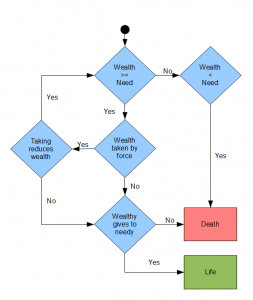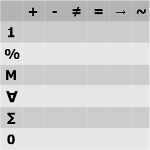My Prediction for the 2012 Presidential Election
Is Romney revolting? Is Obama offensive? Was Ron Paul prevented? I predict most people will be unhappy with the 2012 Presidential election. But there is a cure.
Predicting most people will be unhappy is simple math. Polls show a very tight race between Romney and Obama. If the country were perfectly divided then half the people would be unhappy with the decision. Since there is a substantial amount of people who want someone other than those two that means the majority of people will be unhappy with the result of the election.
What is the cure? More alternatives! No, not more candidates. Electing any one person causes a win lose situation. That will always result in someone being upset and quite often the majority will be unhappy with the result. The cure is more alternatives than electing a president.
Amazingly there are 1,296 alternatives related to any choice. I suspect you never realized those 1,296 alternatives even existed.
The 1,296 alternatives aren’t political parties or even candidates. No matter who is selected for president it’s the same type of choice. It’s a choice for someone else to make your decisions.
To make matters worse, you don’t even get to choose who chooses for you.
Let that sink in a bit. Every decision at the federal level and most decisions at the state and even local level are made by someone other than you. Not only are those choices made by someone other than you, it’s someone who doesn’t even personally know you. How in the world do you think they’ll choose what you want?
The cure is simple, choose a different set of the 1,296 alternatives. So, what are these 1,296 alternatives?
For any decision there is who makes the decision and the actual decision itself. Each of those can be further broken down into categories of 6 Directions and 6 Scales. The 6 Directions and 6 Scales form a grid of 36 Alternatives. The combination of 36 Who Decides and 36 Decisions forms a total of 1,296 Alternatives.
Lets examine Who decides to get a better understanding of the Alternatives.
6 Scales for Who Decides:
- Single 1: One person or type of person decides. Example: individual decision.
- Partial %: Some people decide. Example: Voting where a % makes the decision.
- Multiple M: More than one person required to make a decision. Example: Having a baby requires two people.
- Any ?: Anyone can decide. Example: Freedom, choices over your own property.
- All ?: Everyone required to decide. Example: Criminal jury trial, all 12 members must agree to convict.
- None 0: No one decides. Example: Left to chance. Decision is prohibited.
6 Directions for Who Decides
- Direct +: The person or people directly involved in doing or benefiting from the action make the decision. Examples: personal choice, buying something for cash.
- Opposite -: Decided by a person or persons who oppose the action or who will be harmed by the action. Example: veto.
- Other ?: Someone other than the person it affects. Example: government official.
- Same =: Person stays the same or person is neutral. Examples: Life time appointment. Judge.
- Stabilize ?: Starts as a different alternative before stabilizing: Example: tie breaker.
- Changing ~: Person who decides changes. Example: taking turns deciding.
President is a Single Other Alternative. Other examples of Single Other are: parent, boss, or criminal such as a mugger or rapist.
Nearly all elections in the USA are Partial Other. Either through the party system, or ballot access rules someone else has filtered your available choices.
Supposedly everyone is allowed to vote but people under 18 are not allowed and in many states prisoners are banned from voting. Also people without a fixed address or who split their time between places are only allowed to vote in elections in one place. That means they are prohibited from voting on issues or officials who affect their lives.
So all elections in the USA are Partial Other. That means only 2 of the 36 Alternatives for Who Decides are even offered as choices. That is less than 6% of the Alternatives for Who Decides.
Who Decides isn’t even the most important choice. What you really care about is the actual decision. Again there are 36 Alternatives for the Decision.
6 Scales for Decision
- Single 1: Single decision. Decide once.
- Partial %: Partial decision. Sometimes decide.
- Multiple M: Decide on many things. Decide many times. Multiple alternatives to arrive at decision.
- Any ?: Any option is possible. Decide anytime.
- All ?: All options without compromise. Everything you want. Always decide, not left to chance. Continuously. Continuously decide, moment to moment.
- None 0: Never decide, leave up to chance. Decide to never do it.
6 Directions for Decision
- Direct +: Decide for action. Decision directly connected to the action.
- Opposite -: Decide against action. Decide for opposing action. Decision causes opposite action.
- Other ?: Decide another choice. Action caused `by a different decision.
- Same =: Don’t change existing. Neutral choice. Same choice.
- Stabilize ?: Decision stabilizes. Becomes decision. Starts undecided or as a different decision then becomes the final decision.
- Changes ~: Decision changes. Effect of the decision changes.
Decisions made by government almost always are Single Direct decisions causing You to Pay More Taxes or Single Opposite denying your right to do something. The decisions are single because most laws are never repealed.. So again only 2 of the 36 Alternatives. Combined with Who decides only 0.3% of the Alternatives are ever offered. No wonder so many people complain about government.
Out of 1,296 possible Alternatives 99.7% are ignored.
The 1,296 Alternatives don’t only apply to politics, these are the Alternatives for any decision. This forms the basis of business strategy. The goal of innovation is to satisfy unmet desires. Understanding all of the decisions potential customers can make gives you a significant advantage.
Force, Charity and Logic
 Some people claim wealthy people must be forced to provide for the needy. Logic and evidence show that is false. Charity is always freely given, and that is often.
Some people claim wealthy people must be forced to provide for the needy. Logic and evidence show that is false. Charity is always freely given, and that is often.
This flow chart shows both freely given charity and forced redistribution of wealth. Before we begin what is “needy”. A person is needy if they do not have the items to maintain their natural life. So far human technology is not capable of eternal life, regardless of the amount of physical wealth.
We are all needy at some point. When we are born we are not able to provide for ourselves what we need to continue our lives. So all of us were needy and had that need filled by someone else at some point in our lives. How did that process of being needy and someone deciding to give us what we need work?
Step 1, is the total wealth more than or equal to the total need? That means is there any extra to go around? If there isn’t any extra to go around it doesn’t matter, someone will die. It might be the needy or someone else who becomes needy by giving what they have to someone else. If there isn’t enough for everyone to live then someone dies. If possible we want to avoid that at all costs.
If there is extra there is a choice, is the wealth taken by force? If that happens there is now a new wealthy person. The person who took the wealth is now wealthy. Additionally, taking the wealth by force might reduce the wealth. Fighting to take something from someone who doesn’t want to give it requires some energy and frequently breaking things including killing someone. Just for argument sake we will assume there is also a way to forcibly take wealth from someone without spending any wealth in the process.
If taking the wealth by force reduced the wealth there is a possibility there is now not enough to go around. That is very common. Civil wars in particular leave many people in poverty and starving even if the nation was prosperous before the fighting.
Assuming taking the wealth by force does not reduce the wealth leaves us at the same point as if no force had been used. The original owner of the wealth or the new owner who took it by force decides to give the wealth to the needy or keep it. So it doesn’t matter if force was used or not. The life and death of the needy still depends on the free choice of the wealthy person.
The logic shows that charity is always freely given.
People who argue for using force says, “I’m afraid wealthy people won’t give to the needy. There is no guarantee.” That is absolutely correct. There is no guarantee. There isn’t any guarantee without force and there isn’t any guarantee with force.
As long as there is anyone who is needy, it is impossible to guarantee their needs will be provided. We’ve already shown that using force to redistribute wealth has the risk of decreasing the wealth and making the needy worse off. The solution to the problem of the needy is to create more wealth.
So the logic shows there are two ways to provide for the needy, freely given charity, and increased wealth. Does the evidence agree with the logic? Yes!
The nations with the largest number of needy people, the highest percentage of needy people, and the deepest need are those that are overall the poorest. The wealthiest nations have no truly needy people. There might be people with drastically less wealth than others but except for people willfully rejecting food or shelter there are no starving people in the industrialized nations.
The individuals of wealthy nations either have many opportunities to acquire their own wealth by trade, working the soil, or gifts. There are even people who call themselves Freegans who choose to live from things discarded by others and Freedans claim to live quite well. Freeganism is not to be confused with impoverished people struggling to subsist scrounging from dumps. It’s worth pointing out that one of the reasons there is so much for Freegans to pull out of dumpsters is because of government forced waste.
Wealthy nations also give amazing levels of charity. In the USA the amount of charitable giving $295 billion exceeds the amount of federal government tax funded welfare $254.2 billion.
Not only do people give to charities to help the needy, they also donate to fund projects they like. Contributions to make a movie about the making of the video game Minecraft raised $60,000 more than the $150,000 they requested.
Monetary giving isn’t the only form of charity. Millions of people donate food, and labor to organized charities and directly to individuals. This is over and beyond the monetary giving.
So we can see that the logic proves and the evidence confirms that charity is freely given.




 Predictive Innovation Training
Predictive Innovation Training Predictive Innovation: Core Skills Book
Predictive Innovation: Core Skills Book RoundSquareTriangle.com
RoundSquareTriangle.com